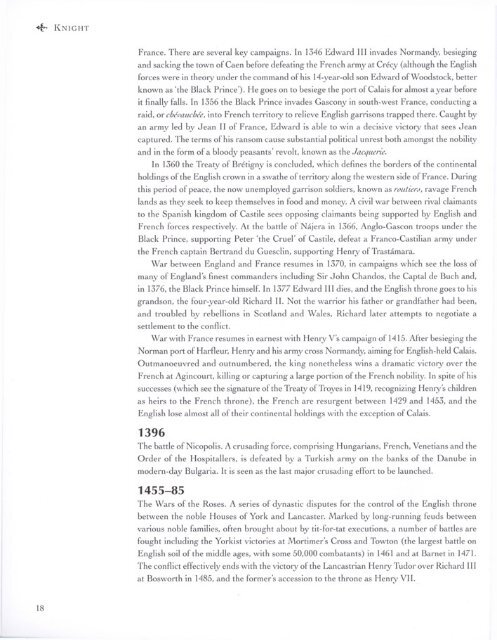Osprey - General Military - Knight - The Warrior and ... - Brego-weard
Osprey - General Military - Knight - The Warrior and ... - Brego-weard
Osprey - General Military - Knight - The Warrior and ... - Brego-weard
Create successful ePaper yourself
Turn your PDF publications into a flip-book with our unique Google optimized e-Paper software.
France. <strong>The</strong>re are several key campaigns. In 1346 Edward III invades Norm<strong>and</strong>y, besieging<br />
<strong>and</strong> sacking the town of Caen before defeating the French army at Crecy (although the English<br />
forces were in theory under the comm<strong>and</strong> of his 14-year-old son Edward of Woodstock, better<br />
known as 'the Black Prince ). He goes on to besiege the port of Calais for almost ayear before<br />
it finally falls. In 1356 the Black Prince invades Gascony in south-west France, conducting a<br />
raid, or chevauchee, into French territory to relieve English garrisons trapped there. Caught by<br />
an army led by Jean II of France, Edward is able to win a decisive victory that sees Jean<br />
captured. <strong>The</strong> terms of his ransom cause substantial political unrest both amongst the nobility<br />
<strong>and</strong> in the form of a bloody peasants' revolt, known as the Jacquerie.<br />
In 1360 the Treaty of Bretigny is concluded, which defines the borders of the continental<br />
holdings of the English crown in a swathe of territory along the western side of France. During<br />
this period of peace, the now unemployed garrison soldiers, known as routierj, ravage French<br />
l<strong>and</strong>s as they seek to keep themselves in food <strong>and</strong> money. A civil war between rival claimants<br />
to the Spanish kingdom of Castile sees opposing claimants being supported by English <strong>and</strong><br />
French forces respectively. At the battle of Najera in 1366, Anglo-Gascon troops under the<br />
Black Prince, supporting Peter 'the Cruel' of Castile, defeat a Franco-Castilian army under<br />
the French captain Bertr<strong>and</strong> du Guesclin, supporting Henry of Trastamara.<br />
War between Engl<strong>and</strong> <strong>and</strong> France resumes in 1370, in campaigns which see the loss of<br />
many of Engl<strong>and</strong>'s finest comm<strong>and</strong>ers including Sir John Ch<strong>and</strong>os, the Captal de Buch <strong>and</strong>,<br />
in 1376, the Black Prince himself. In 1377 Edward III dies, <strong>and</strong> the English throne goes to his<br />
gr<strong>and</strong>son, the four-year-old Richard II. Not the warrior his father or gr<strong>and</strong>father had been,<br />
<strong>and</strong> troubled by rebellions in Scotl<strong>and</strong> <strong>and</strong> Wales, Richard later attempts to negotiate a<br />
settlement to the conflict.<br />
War with France resumes in earnest with Henry V's campaign of 1415. After besieging the<br />
Norman port of Harfleur, Henry <strong>and</strong> his army cross Norm<strong>and</strong>y, aiming for English-held Calais.<br />
Outmanoeuvred <strong>and</strong> outnumbered, the king nonetheless wins a dramatic victory over the<br />
French at Agincourt, killing or capturing a large portion of the French nobility. In spite of his<br />
successes (which see the signature of the Treaty of Troyes in 1419, recognizing Hemy's children<br />
as heirs to the French throne), the French are resurgent between 1429 <strong>and</strong> 1453, <strong>and</strong> the<br />
English lose almost all of their continental holdings with the exception of Calais.<br />
1396<br />
<strong>The</strong> battle of Nicopolis. A crusading force, comprising Hungarians, French, Venetians <strong>and</strong> the<br />
Order of the Hospitallers, is defeated by a Turkish army on the banks of the Danube in<br />
modern-day Bulgaria. It is seen as the last major crusading effort to be launched.<br />
1455-85<br />
<strong>The</strong> Wars of the Roses. A series of dynastic disputes for the control of the English throne<br />
between the noble Houses of York <strong>and</strong> Lancaster. Marked by long-running feuds between<br />
various noble families, often brought about by tit-for-tat executions, a number of battles are<br />
fought including the Yorkist victories at Mortimer's Cross <strong>and</strong> Towton (the largest battle on<br />
English soil of the middle ages, with some 50,000 combatants) in 1461 <strong>and</strong> at Barnet in 1471.<br />
<strong>The</strong> conflict effectively ends with the victory of the Lancastrian Henry Tudor over Richard III<br />
at Bosworth in 1485, <strong>and</strong> the former's accession to the throne as Henry VII.







